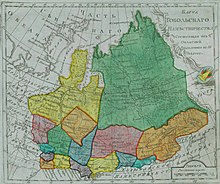|
Tobolsk Viceroyalty
 Tobolsk Viceroyalty (Russian: Тобольское наместничество, romanized: Tobol'skoye namestnichestvo)[2][3][4] was an administrative-territorial unit (namestnichestvo)[5] of the Russian Empire, which existed in 1782–1796. It was located in Siberia with its capital in Tobolsk. HistoryEstablishmentThe Tobolsk Viceroyalty was established by the personal decree of Catherine II[6] from the territory of the dissolved Tobolsk province.[7] In 1780–1782, the three-story stone Palace of the Tobolsk Viceroys was rebuilt in Tobolsk. The palace was located on the site of the old clerk's chamber, built by Semyon Ulyanovich Remezov, on a high ravine between the Pryamskoy Vzvoz (gatehouse of the Tobolsk Kremlin) and the banks of the Irtysh river. In its spacious throne room, furnished with expensive carpets, was the gold-decorated imperial throne, from the steps of which the Tobolsk Viceroys received officials and foreign ambassadors.[8] To commemorate the opening of the Tobolsk Viceroyalty, ceremonial events were held in August 1782. In attendance were the Khan of the middle Kirghiz horde with the sultans, the Vogul ancestors, Prince Taishin of the Principality of Obdorsk, and other Ostyak princes.[8] Celebrations in Tobolsk began on August 21, 1782. In the evening, Major Yakov Meibom, who was appointed mayor, second-major, and collegiate secretary Matvey Yurlov, 6 horse trumpeters and 12 hussars, informed Tobolyakov and guests of the city about the upcoming festivities. At 4:00 a.m., after a cannon shot, a military team of 1,000 people arrived at the Tobolsk Kremlin. At 7:00 a.m. following another cannon shot, commanding officials began to arrive at the Viceroy’s Palace, to be met by Governor General, Lieutenant General of the Life Guards, and Prime Major Yevgeny Petrovich Kashkin. Another cannon shot at 8:00 a.m. signalled the beginning of a church service led by Archbishop of Tobolsk and Siberia, which was attended by all officials. They arrived at the Cathedral from the Viceroy's Palace in a special procession, proceeding along a special platform upholstered in scarlet cloth. During the prayer service, two rapid canon salutes were performed using 101 cannons. The prayer service was followed in turn by a celebratory dinner, an evening ball, and a supper after midnight.[9] On August 23, 1782, a dinner was given in the throne room of the Tobolsk Viceroy's Palace.[9] On August 30, 1782, the formal opening ceremony of the Tobolsk Viceroyalty took place. According to the description of Abramov N.A., from the words of a participant in these celebrations:
This description of the celebrations possibly belongs to Pyotr Slovtsov, a 15-year-old student of the Tobolsk Theological Seminary who read the ode "To Siberia" of his own composition at the celebrations from the seminary.[8][10]
StructureIn 1785, the Tobolsk Viceroyalty consisted of two regions: Tobolsk Oblast and Tomsk Oblast. The oblast (region) is an intermediate link in territorial administration between the namestnichestvo (vicegerency) and the uezd (county). By that, the administration of Empress Catherine II adapted the governing system to the vast Siberian territories. Tobolsk Oblast includes 10 uezds: Beryozovsky Uezd, Ishimsky Uezd, Kurgansky Uezd, Omsky Uezd, Surgutsky Uezd, Tarsky Uezd, Tobolsky Uezd, Turinsky Uezd, Tyumensky Uezd, and Yalturovsky Uezd—the uezd-less town of Pelym (located within Turinsky Uezd), and 11 fortresses that made up the Ishim line (the southern border of Kurgansky Uezd, Ishimsky Uezd, and Omsky Uezd). Tomsk Oblast includes 6 uezds: Achinsky Uezd, Yeniseisk Uezd, Kainsky Uezd, Narymsky Uezd, Tomsk Uezd, and Turukhansky Uezd.
SettlementsAccording to Catherine II's regional reform of 1785, which transformed provincial governments into viceroyalties, for a population to be considered a city, it required a special letter from Catherine II— creating a self-governing city society with rights as a legal entity—as well as the highest approved coat of arms[11][12] and city plan.[13][14] From 1788 until the early 1790s, general city dumas were organized in eight cities of the Tobolsk Viceroyalty: Tobolsk, Tomsk, Tyumen, Tara, Turukhansk, Yeniseisk, Narym, and Omsk. The following cities were re-established in the Tobolsk Oblast: Omsk, from the Omsk fortress; Ishim, from the Korkina settlement; Kurgan, from the Kurgan settlement (Tsarevo Gorodishe settlement); and Yalutorovsk, from the Yalutorovsky ostrog. The Tobolsk Viceroyalty had an area of 5 million square verst. It contained 16 cities, 16 ostrogs and suburbs, 42 pogosts, 43 slobodas, 124 villages; 10 fortresses; 5 monasteries; 18 outposts, camps, and redoubts; 2,994 villages and winter quarters; 1,232 auls and yurts of non-Christians; 72 landowners' lodges; and 6 state-owned and 14 private manufacturing establishments. In the vicegerency, 224 volosts of Russian settlers and 156 volosts of other faiths were organized.[4] GovernmentThe management of the Tobolsk Viceroyalty[15][16] was united with that of the Perm Viceroyalty under the authority of the governor-general, in whose hands all the threads of economic, police, and judicial administration were concentrated. He had full administrative and military power in the territory. E. P. Kashkin was appointed the first governor-general of the Tobolsk Viceroyalty and Perm Viceroyalty.[4] The Tobolsk Viceroyalty belongs to the I category (status, depending on which monetary payments were assigned to officials who served in them), uniting territories that had a more standardized administration.[13] DisestablishmentIn 1796, the Tobolsk Viceroyalty was abolished by Paul I, and its territory was transferred to the newly formed Tobolsk Governorate. PopulationThe population of the Tobolsk Viceroyalty was represented by the following national and ethnic groups: Russians, Tatars, Сhuvalshchiki quitrents (Muslim settlers from other provinces, recorded as settled foreigners and endowed with 15 dessiatins of land[17]), Bukharians, Ostyaks, Voguls, Samoyeds, Tungus, Chapogirs (one of the Yenisei clans of Tungus[18]), and Yakuts.[4] EconomyIn 1783, there was a crop failure in the Tobolsk Viceroyalty.[19] See alsoReferences
|
||||||||||||||||||||||||||||||||||||||||||||||||||||||||||||||||||||||||||||||||||||||||||||||||||||||||||||||||||||||||||||||||||||||
Portal di Ensiklopedia Dunia





















